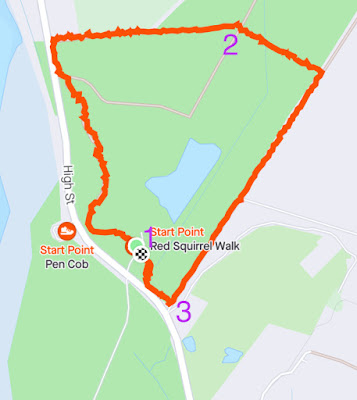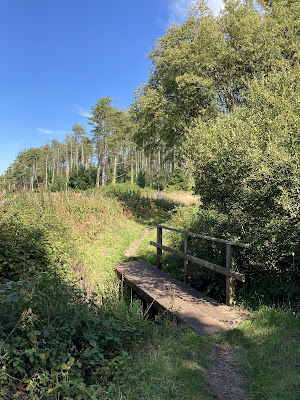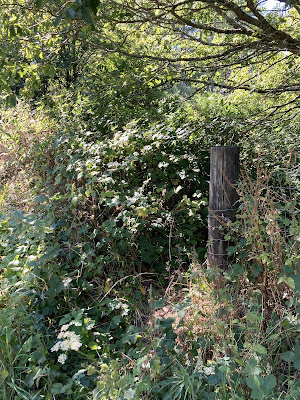Time taken: 1hr 12 moving time (the girls were on a proper go slow today!)
Elevation gain: 7m (Strava app)
Parking: Yes.
Facilities: None
Walkers: Me (34years, fat and unfit), Megan (5yrs, full of energy and never stops talking), Anwen 2yrs, (getting more and more independent.), Nain (70s, fit but struggles with her knees)
1. To park, drive through Niwbwrch heading for Malltraeth. You’ll come into the forest and most car parking spaces are on the left. This place is on the right, straight after a single track lane. If you get to the cob at Malltraeth, you’ve gone too far.
There’s limited parking but it is free. Pretty much everywhere was full to the brim today but I managed to squeeze my car in along the side of the entrance road, like many others had done. As long as you’re not blocking any access (making sure in particular that an ambulance or fire engine could get through) I don’t think that’s a problem.... maybe don’t quote me on that though!
There is a sign in the car park with a map of the area. We mostly stuck to the Red Squirrel Walk for the first half. We did it clockwise though, whereas the signs on the route point you counter-clockwise!
Map and info in the car park.
Newborough Forest and Llyn Parc Mawr (Big Park Lake - Llynne Park Ma-oor)
The people of Newborough originally came from the village of Llanfaes, which unfortunately happened to be the site that Edward I chose to build Beaumaris Castle. As a result, the inhabitants of the village were all evicted at the end of the 13th century and re-housed in the ‘New- borough’ at the opposite end of the island, where it became a prosperous town surrounded by rich farmland. This corner of the island was famous, even before Edward I created Newborough, because it was the site of one of the royal palaces, or llysoedd, of the Princes of Gwynedd at Llys Rhosyr.
However, in the 14th century a series of violent storms buried a large portion of this area under sand dunes. To stop the advance of the dunes, marram grass was planted and soon provided raw material for a new industry in the town, the weaving of the marram grass leaves to form mats and baskets. Rabbits colonised the dunes, giving the area the name Newborough Warren.
In order to further protect the village from shifting dunes, which often covered the area in a blanket of sand, the Forestry Commission planted the present day forest, consisting mainly of Corsican Pine, soon after the Second World War, and this quickly became a popular amenity in addition to the beach and Warren.
The forest has become famous for both its raven roost, which has been estimated to number 800-1200 during summer, and for the successful re-introduction of the red squirrel.
In 2014 over 80 people living in the Newborough and district area held a meeting to discuss the possibility of the community being involved with the management of Newborough Forest. Following three more community meetings they created the Llyn Parc Mawr Community Woodland Group. A period of negotiation with Natural Resources Wales ended in a management agreement for 50 acres of Newborough Forest.
The purpose of the company is to establish Llyn Parc Mawr as a sustainable woodland area to benefit wildlife and contribute to the well-being of the community of Newborough and District, and for public enjoyment.
The footpath is very easy to follow, even if you are doing it backwards! For the first part it’s just one single track and it’s pretty difficult to get lost. There was loads of beautiful plants and bugs to see (Megan counted 41 butterflies, 2 dragonflies and numerous damselflies. We also saw two frogs.) We didn’t see any red squirrels but that’s not a surprise given how much noise a 2 and a 5 year old make!
Red squirrels.
The number of red squirrels has dramatically declined in the U.K. over the last 100 years. This is as a result of loss of broadleaf habitat and the impact of grey squirrels who compete for resources and who carry a virus which is fatal to reds.
Up to the 1950s red squirrels were abundant on Ynys Môn. During the 1970s grey squirrels were increasingly seen on the island having either swum the Menai or crossed using one of the two bridges. It is believed that the red squirrel population declined dramatically in the late 1980s as the number of greys increased. During the 1990s sightings of red squirrels were rare. By 1997 the red squirrel population on Ynys Môn was close to extinction with fewer than 40 adults remaining all in one woodland and from one female line.
A conservation project was set up to re-introduce reds onto the island. The population went from 40 to around 700. This was done by the eradication of grey squirrels combined with a reintroduction programme. Today 60% of Welsh red squirrels can all be found all over Anglesey. The island was declared grey squirrel free in 2016.
Reds were introduced into Newborough Forest in 2004, where they bred successfully and can now be found throughout the woodland especially within Llyn Parc Mawr. The Woodland group finance the food fed to the red squirrels and have worked hard to produce a diverse habitat for all wildlife.
Leaving the car park.
Straight into beautiful woodland.
They can’t just stick to paths!
Pili Pala (Peelee Pahlah)
“Look, a cave!”
Beautiful.
Anwen attempting to hop!
Eventually the track turns 90 degrees to the right, away from the road, and opens up a bit. There is access here on the left from Cob Malltraeth (
Cob Mah-ll-trah-eeth)
Malltraeth Cob.
The Cob is a low embankment and bridge. It was authorised by Parliament in 1790. The original lasted only a few years before a storm tide broke it in two places. It was rebuilt in 1812 and was a key element of the infrastructure which drained the Cefni saltmarsh.
It’s local importance is reflected in the words of the folk song ‘Cob Malltraeth’, in which the singer imagines the consequences should the Cob break.
“Os torrith cob Malltraeth fe foddith fy mam
Mae 'rnaf ofn yn fy nghalon, ti-rai, twli wli ei,
Mae 'rnaf ofn yn fy nghalon mai fi caiff y cam.”
(If Malltraeth Cob should break, my mother will drown
I fear it in my heart, ti-rai, twli wli ei,
I fear it in my heart that I will be the one to suffer.)
Before the area was drained, the Cefni flowed slowly through an expanse of mud and sand. The village of Malltraeth takes its name from this expanse. Malltraeth means ‘unwholesome strand’ and is recorded from at least 1304. The extent of the previous strand or beach is reflected in the names Trefdraeth and Glantraeth, north of Malltraeth and now far from the shore.
Nice grassy track.
Over a bridge.
And another bridge.
Damselfly.
It was along this stretch that Anwen decided she was too tired to walk (in her defence she’s in that difficult age where she’s dropping naps but could still do with them! She’s also a ginge and it was pretty hot!) so, because I hadn’t brought the rucksack, I ended up carrying her on my shoulders most of the way back!
Happy.
2. At the end of this section we diverted from the squirrel walk and kept straight on rather than turning right. This did mean that we missed the lake viewpoint, so that’s worth bearing in mind. There are a couple of wooden bridges to cross, one with a couple of uneven steps up and down. We did see some frogs along here and the bulrushes were amazing.
Straight on.
View from a bridge.
Wedi blino - tired.
At the end of this section we come onto a single track lane and turn right, back towards the main road. There are some lovely views along here across open fields and out towards the mountains.
The lane.
Pretty views.
3. We walk the track until we can see the main road but we turn right, into the forest, just before we get to the road.
The road is a fast and busy one, and I’m not sure that there’s a pavement to speak of, so although the path we took isn’t an official one... it’s safer with young kids. There is a gap for access around the fence, and although it was a bit overgrown to start with, it’s clearly a well used route.
Nearly at the main road.
Nip around the fence.
She regained her energy!
Pretty forest.
After a short while we get back to the car park. Before that though we pass a circle of stumps, which the girls loved (fairies everywhere!) and the Caban. As previously mentioned, part of the Woodland Group’s aim is to provide education and a space for the community to enjoy. These areas are used as part of that goal. There is, in fact, a forest school for preschool and home-educated children. Loads of information can be found at the Llyn Parc Mawr website
https://www.llynparcmawr.org/

Tylwyth Teg! (Fairies)
Someone’s getting a lecture.
Megan.
Anwen.
Caban.
Inside the Caban.
Back to the car.
This is a gentle, straightforward walk and great for young kids. It’s also nice and quiet as most people will head for the more well known parts of Newborough Forest and the beach.


































Comments
Post a Comment